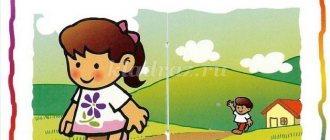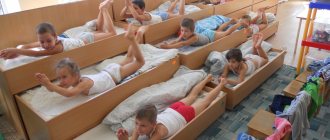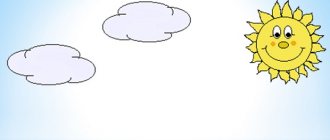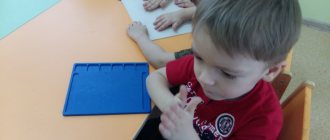Card index “Physical education in the second junior group”
Abdulova Dzhume Sirazhutdinovna
Card index “Physical education in the second junior group”
Lesson 1
Tasks. Practice walking between objects, running in all directions; in maintaining stable balance when walking on increased support; in jumping.
Part 1. Walking in a column one at a time; walking between objects (cubes, skittles placed along the hall; the distance between them is 1 m. Children in a column, one at a time, walk between objects in a “snake” manner. When the last child in the column passes between the objects, the command is given to run in all directions. The task is repeated twice.
Part 2. General developmental exercises with a hoop.
1. I. p. – feet at the width of the foot, hoop with a grip from the sides, below. Raise the hoop up, look out the “window”, lower the hoop down, return to the starting position (5 times).
2. I. p. – standing with feet hip-width apart, hoop in bent arms near the chest, grip of arms from the sides. Sit down, bring the hoop forward, rise, return to the starting position (4 times).
3. I. p. - feet shoulder-width apart, hoop in bent arms near the chest. Raise the hoop up, lean to the right (left); straighten up, return to the starting position (2-3 times).
4. I. p. - standing in a hoop, legs slightly apart, hands on the belt. Jumping on two legs in a hoop, alternating with a short pause.
Main types of movements.
Equilibrium. Walking on the board sideways with an extended step, hands on the belt, at a moderate pace. At the end of the bench, step down and step forward. The teacher provides assistance and insurance (2-3 times).
Jumping from bump to bump. Along the opposite sides of the hall there are 5-6 hoops at a distance of 50 cm from one another in a checkerboard pattern. After the teacher shows and explains the task, the children line up in two columns and perform jumps from hoop to hoop in a continuous manner. The teacher makes sure that the children push off energetically from the floor and land on bent legs, maintaining the required distance.
Outdoor game "Hen and Chicks".
3rd part. Game "Let's find the chicken."
Lesson 2
Tasks. Exercise walking with stepping, developing coordination of movements; repeat tasks in jumping and throwing a ball.
Part 1. Walk in a column one at a time, stepping over the cords with your right and left feet alternately. The cords are placed at a distance of 30–35 cm from one another (child’s step). The main thing is that there are no extra steps. Then the command is given to run in all directions, using the entire area of the hall.
Part 2. General developmental exercises.
1. I. p. - legs at the width of the foot, arms along the body. Raise your arms up to your sides, clap your hands above your head; lower your arms, return to the starting position (9 times).
2. I. p. - feet width apart, hands behind the back. Sit down, clap your hands in front of you; straighten up, return to the starting position (4 times).
3. I. p. – feet shoulder-width apart, arms to the sides. Tilt to the right, touch your right leg with your palm, straighten up, arms to the sides. The same to the left (4–5 times).
4. I. p. - feet shoulder-width apart, hands on the belt. Turn to the right, arms to the sides; return to the starting position. The same to the left (3 times).
5. I. p. – legs slightly apart, arms at random. Jump on two legs with a turn to the right, return to the starting position. The same to the left (3-4 times).
Main types of movements.
Jumping "Across the Ditch" In the hall, on both sides of the cords there are 4–5 “grooves” (30 cm wide), one parallel to the other. Children in two columns perform jumps on two legs from “groove to groove”: waving their arms, they energetically push off from the floor and land on half-bent legs.
The exercise is repeated 2-3 times.
Funny Ball Throwing. After performing the jumps, the children take one ball from the box (basket). The children stand in a semicircle, or in two ranks, or randomly throughout the hall. The teacher shows and explains the exercise: “Feet shoulder-width apart, ball in bent arms near the chest. You need to throw the ball at the toes, catch it with both hands after bouncing off the floor, trying not to press it to your chest.” Children take their starting position and throw balls at a signal. After all the children have caught the balls, the signal is given for the next throw. The exercise is repeated 8-10 times.
Outdoor game “Birds in nests”.
3rd part. Walking in a column one at a time.
Lesson 3
Tasks. Practice walking and running in a circle, turning at a signal; repeat rolling balls, developing dexterity and eye; crawling in a straight line.
Part 1. Walking and running around the cubes with a turn in the other direction at the teacher’s signal (cubes according to the number of children). After walking and running exercises, the teacher invites each child to take a cube. Formation in a circle.
Part 2. General developmental exercises with a cube.
1. I. p. – legs at the width of the foot, cube in the right hand below. Raise your arms up through your sides, transfer the cube to your left hand, lower your hand. The same with the left hand (3-4 times).
2. I. p. – feet shoulder-width apart, cube behind back in right hand. Bend over, put the cube on the floor, straighten up; bend over, take the cube in your left hand, straighten up. And so on alternately (4 times).
3. I. p. - sitting, legs crossed, cube in right hand. Turn to the right, place the cube at the toes; straighten up, hands on your waist. Turn to the right, take the cube, transfer it to your left hand. The same to the left (3 times).
4. I. p. – legs slightly apart, arms at random, cube on the floor. Jumping on two legs around the cube in both directions (2-3 times).
Main types of movements.
“Ride between objects.” Rolling balls between medicine balls (4-5 pieces, lying at a distance of 1 m from each other. The ball moves like a “snake” between objects - children push it with two hands folded in a “boat”. At the end of the exercise, you need to take the ball in your hands and lift it over your head and stretch.
Crawling in the forward direction “Funny Bugs”. Crawling on a gymnastic bench on your hands and knees - fast, like bugs. It is performed in-line in two columns (2–3 times).
Outdoor game "Frogs".
3rd part. Walking in a column one at a time.
Lesson 4
Game exercises on the covered and mastered material.
1. "Beetles." At the teacher’s signal: “The beetles have flown!” - the children scatter all over the hall. At the signal: “The beetles are resting,” the children lie on their backs and move their legs and arms, as if moving their paws. Then the “bugs” fly again and rest (you can use musical accompaniment).
2. "Ride - catch." Children are divided into threes and take their starting position - sitting, legs apart. In the hands of one of the players is a ball of large diameter. At the signal: “Let’s go!” – children take turns rolling the ball to each other.
3. Outdoor game “Find your color.”
Physical education classes in the second junior group for November
Abdulova Dzhume Sirazhutdinovna
Physical education classes in the second junior group for November
Lesson 1
Tasks. Exercise children in balance when walking on a limited area of support, in landing on bent legs when jumping.
Part 1. Game building "Merry Mice". Walking in a column one at a time. At the teacher’s signal: “Mice!” – children begin to walk on their toes in short, mincing steps, with their hands on their belts. On the signal: “Butterflies!” - to run. Walking and running are carried out in alternation.
Part 2. General developmental exercises with ribbons.
1. I. p. - legs at the width of the foot, ribbons in the lowered hands. Raise the ribbons up, wave them, lower them; return to the starting position (4–5 times).
2. I. p. - legs at the width of the foot, ribbons in both hands at the shoulders. Sit down and tap your chopsticks on the floor. Rise, return to starting position (4 times).
3. I. p. – stand with feet shoulder-width apart, ribbons at the shoulders. Turn to the right (left, right hand to the right (left). Straighten up, return to the starting position (3 times in each direction).
4. I. p. - legs at the width of the foot, ribbons below. Swing the ribbons to the sides, lower them, return to the starting position (5 times).
Main types of movements.
Balance “Into the forest along the path.” Two boards (width 25 cm, length 2–3 m) are laid parallel to each other on the floor - “paths to the forest.” Walk at a moderate pace along one path, then along a second, balancing with your arms to maintain balance.
Jumping “Bunnies are soft little paws.” Children “bunnies” stand in one line. The teacher invites the “bunnies” to jump on soft paws to the edge of the forest. At the teacher’s signal, children jump on two legs and move to the edge of the forest (distance 3–4 m). The children walk back to the starting line.
Outdoor game "A clever driver".
3rd part. Game "Let's find the bunny."
Lesson 2
Tasks. Practice walking in a column one at a time while completing tasks; when jumping from hoop to hoop, learn to land on bent legs; practice rolling the ball to each other, developing coordination and eye control.
Part 1 . Walking in a column one at a time with high knees, wide free steps; hands on the belt - “horses”. Run, arms to the sides - “dragonflies”. Walking and running in alternation. To perform general developmental exercises with a hoop, the teacher helps children form the letter “P”.
Part 2. General developmental exercises with a hoop.
1. I. p. - legs at the width of the foot, a hoop in both hands on the shoulders - “collar”. Raise the hoop up, arms straight, look into the hoop; lower it, return to the starting position (5 times).
2. I. p. - standing in a hoop, legs slightly apart, hands behind your back. Sit down, take the hoop with both hands (grip from the sides, straighten up, lift the hoop to your waist. Sit down, put the hoop on the floor, stand up, put your hands behind your back (4-5 times) (Fig. 10).
3. I. p. - sitting, legs apart, hoop in both hands near the chest. Bend over, touch the floor with the rim of the hoop, straighten up, return to the starting position (5 times).
4. I. p. - feet shoulder-width apart, hoop in bent arms near the chest. Turn right (left) slowly; straighten up, return to the starting position.
Main types of movements.
Jumping "Through the Swamp". From 8-10 flat card hoops (or cords) with a diameter of 30–40 cm, “bumps” are laid out in a checkerboard pattern on two sides of the hall. Children stand in two columns. The teacher suggests crossing the “swamp” by jumping on two legs from one “bump” to another. Jumps are performed alternately, one after another. The teacher reminds that you need to jump with your knees bent and land on bent legs (there should be a certain distance between the children).
After all the guys have “crossed the swamp,” there is a short pause, and the game task is repeated. The number of repetitions depends on the conditions and physical fitness of the children. The pace of exercise is moderate.
Rolling balls “Accurate pass”. Children stand in two lines following landmarks (cord, colored marks). The distance between the ranks is 2 m. One rank receives balls (or children take balls from the basket). At the teacher’s signal: “Let’s go!” – children roll the balls with an energetic movement with both hands towards a partner from another line (pairs are determined in advance). The game task is repeated 8-10 times in a row.
Outdoor game “Mice in the pantry”. The “mice” children sit in “holes” - on benches placed along one wall of the hall. On the opposite side of the hall there is a rope stretched at a height of 50 cm from the floor level, behind it there is a “storage room”.
The teacher, the “cat,” sits next to the players. “Cat” falls asleep, and “Matti” runs to the pantry. Entering the pantry, they bend down so as not to touch the rope. There they squat down and “gnaw crackers.” The “cat” wakes up, meows and runs after the “mice”. They run away into the “holes” (the cat does not catch mice, but only pretends to want to catch them). The game resumes. After some time, when the game is repeated, the role of the cat can be played by the most prepared child.
3rd part. Game “Where is the mouse hiding?”
Lesson 11
Tasks. Develop the ability to act on a signal from the teacher; develop coordination of movements and dexterity when rolling the ball between objects; practice crawling.
Part 1. Game exercise “Your cube”. Cubes are laid out in a circle (according to the number of children). Walking in circles. After the children have walked half the circle, the teacher gives the command: “Take the cube!” Children turn to face in a circle, each child takes the cube that is closest to him and raises it above his head.
To the teacher’s next command: “Circle!” - children put the cubes in place, and walk in a circle in the other direction. The exercise is repeated. After walking, you run in a circle, first in one direction and then in the other direction.
Part 2. General developmental exercises.
1. I. p. - legs at the width of the foot, arms along the body. Raise your arms up, stretch, squat, put your hands on your knees (5 times).
2. I. p. - sitting on the floor, legs apart, arms supported behind. Raise your right (left) leg forward and up; lower your leg, return to the starting position (3 times with each leg).
3. I. p. - lying on your stomach, arms bent at the elbows in front of you. Understand that your arms are forward and up, your legs are slightly raised - “fish”. Return to starting position (5 times).
4. I. p. - standing, feet shoulder-width apart, hands on the belt. Tilt the torso to the right (to the left, straighten up, return to the starting position (3 times in each direction).
Main types of movements.
Game task with the ball “Ride it, don’t hit it.” Children stand in two lines, each child has a ball of medium diameter. The teacher places cubes (or medicine balls) along the hall in two lines, at a distance of 1 m from each other (5-6 pieces each). One child from each line stands on the starting line and begins to roll the ball between objects, pushing it with both hands, without letting go far away from themselves. The teacher invites the next pair of children as soon as the previous children have covered a third of the distance, and so, one after another, the children perform the exercise. After completing the task, the children approach the hoop, take a step and raise the ball high above their heads. Return to The child should line his line from the outside.
“Crawl through - don’t hit me.” Crawling on all fours (supporting on the palms and knees) between objects without touching them (“snake”). The game task “Fast Bugs” is performed in two columns (organization is approximately the same as in the previous exercise; after crawling, stand up, straighten up and clap your hands above your head).
Outdoor game “On a level path.” The teacher brings the children into a circle and invites them to play. Reads a poem:
On a smooth path,
On a flat path
Our feet are walking:
One, two, one, two,
By pebbles, by pebbles...
Into the pit - bang!
Children perform walking, and to the words “over the pebbles, over the pebbles” they jump on two legs, moving forward slightly, to the words “into the hole - bang!” squat down. “We got out of the hole,” says the teacher, and the children rise. The game repeats itself. In order to prolong one or another type of movement of children, the teacher can repeat each line of the poem several times.
Part 3 . Walking in a column one at a time or a low-mobility game at the children's choice.
Lesson 3
Tasks. Exercise children in walking while completing tasks, developing attention and reaction to the teacher’s signal; in crawling, developing coordination of movements; in balance.
Part 1. Walking in a column one at a time to complete a task, running in a column one at a time. The teacher explains the task to the children: the word: “Frogs!” – sit down, put your hands on your knees, then get up and continue walking. Switch to running at the teacher’s signal and then start walking again. To the word: “Butterflies!” – stop and wave your arms like wings. Walking and running are carried out in alternation.
Part 2. General developmental exercises with flags.
1. I. p. – legs at the width of the foot, flags in both hands below. Raise the flags up, arms straight; lower the flags, return to the starting position (5 times).
2. I. p. – feet shoulder-width apart, flags at the shoulders. Turn to the right, right hand to the right, straighten up, return to the starting position. The same to the left (3 times in each direction).
3. I. p. - feet shoulder-width apart, hands with flags behind the back. Lean forward and down and wave the flags left and right. Straighten up, return to the starting position (5-6 times).
4. I. p. - legs at the width of the foot, flags below. Wave the flags back and forth. Lower the flags down, return to the starting position (4-5 times).
5. Walking in a column one at a time. Children place flags in the place indicated by the teacher (running with flags should be excluded due to possible injuries).
Main types of movements.
Crawl. Game task – “Spiders”. Two boards are laid parallel to one another on two sides of the hall. Children crawl in two columns along the board, supported on their palms and knees, quickly - “like spiders.” The teacher adjusts the distance between the children so that they do not bump into each other. After crawling, the child approaches the cord, steps over it and claps his hands above his head (repeat 3 times).
Equilibrium. On the side of each board, approximately in the middle, a cube (or any object) is placed on the floor. Walking is performed at a moderate pace at a short distance from each other - arms to the sides, balancing freely, helping to maintain stable balance. You need to stop near the cube, perform a squat (not very deep) and continue walking. The teacher reminds the children that at the end of the exercise they need to go around the board from the outside and go to their column (2-3 times).
Outdoor game “Catch a mosquito.” The players stand in a circle with their arms raised to the sides. The teacher is in the center of the circle and rotates a stick with a long rope at a distance of approximately 120 cm from the floor in both directions, to the end of which a mosquito (cut out of cardboard) is attached. As the mosquito approaches, children jump up on two legs, trying to touch (catch) the mosquito.
3rd part. Walking in a column, one at a time, behind the “mosquito”. The stick with the “mosquito” is carried at the head of the column by the child who managed to catch it more often than others in the game.
Material to repeat
1st week. Game exercises: climbing under an arc (cords); with a ball - “Roll the ball and crawl”, “Roll and catch the ball; balance – “Run along the bridge (along the path).” Outdoor games “Mice in the pantry”, “Train”, “On a level path”.
2nd week. Game exercises: balance - walking from hoop to hoop; jumping - “Jump from hole to hole (from hoop to hoop). Outdoor games “Hen and Chicks”, “Catch the Ball”.
3rd week. Game exercises: jumping - to a cube, to a hoop, to a toy; “Jump over the stream”; with a ball - “Roll the ball to the pin and knock it down.” Outdoor games “Catch a mosquito”, “Cat and mice”, “Find your house”.
4th week . Game exercises with a ball - rolling balls in pairs; “Ride through the gate”; crawling - “Crawl to the bunny (on your palms and knees, climbing under an arc (“mice”, “kittens”). Outdoor games “Bubble”, “Catch a mosquito”, “The gray bunny washes itself.”




